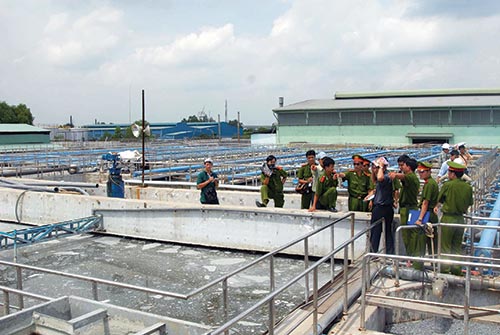Firms flout enviroment laws

Businesses continue to ignore basic regulations to prevent environmental pollution
Under the Central Institute for Economic Management’s (CIEM) survey on over 2,000 Vietnamese production small and medium-sized enterprises released in early November, only 16.2 per cent of respondents had environmental standard certificates (ESC). The rate was 16 per cent in 2011.
Ho Chi Minh City has the highest rate of 27.7 per cent, followed by Long An province (23.5 per cent), Hanoi (22.3 per cent) and Haiphong (18.3 per cent).
Under Vietnam’s environmental legal documents, when enterprises conduct production activities, they must carry out an environmental impact assessment (EIA) report which is supposed to be appraised by a council and approved by government agencies.
An ESC will be granted to enterprises if environmental protection solutions in the EIA report are approved.
“In general, enterprises completely lack awareness of the importance of environmental law on their performance,” the report said. “About 80 per cent of the respondents have no knowledge about the environment. Only a fifth of the respondents say that their environmental knowledge is at a good or average level.”
According to the Ministry of Public Security’s Department for Environmental Crime Prevention, many enterprises were taking advantage of lax environmental management.
“It would be very expensive to install a modern environmental protection system. Many enterprises seem to accept punishments rather than investing in building such systems,” said Vietnam Association for Environmental Impact Assessment president Nguyen Khac Kinh. “Polluters can be found everywhere, mostly in industrial development areas like Hanoi, Ho Chi Minh City, Binh Duong, and Dong Nai.”
Nearly 6,100 environmental pollution cases with fines running into hundreds of thousands of dollars were recorded in the first half of the year.
Ho Chi Minh City recently named 54 businesses causing environmental pollution. This included 13 enterprises guilty of serious pollution, including some foreign enterprises like the Philippines’ garment maker Altamode Vietnam, and South Korea’s garment producer Nahal Vina and sports shoes maker Vietnam Samho.
These polluters have been examined and forced to improve their environmental protection systems.
The CIEM report also revealed that firms had cut investment into environmental equipment by 40 per cent, from VND155 billion ($7.38 million) in 2011 to VND96.5 billion ($4.6 million) in 2013.
“There remain many things to be done to raise awareness of environmental regulations among SMEs,” the report suggested.
According to the Environmental Performance Index 2014 (EPI) recently released by Yale University - which ranks how well countries perform on high-priority environmental issues in protection of human health from environmental harm and protection of ecosystems - Vietnam was listed 136th out of 178 nations surveyed. The country was also ranked at the lowest level among all ASEAN nations.
Vietnam stands 111th in terms of health impacts, air quality (170th), water and sanitation (95th) and water resources (140th).
According to the Ministry of Natural Resources and Environment’s September-released report on air quality from 2008-2013 in Vietnam, rampant air pollution remained almost unchanged since 2003-2007, with many types of pollutants far exceeding permissible limits, causing health problems for people nationwide, especially in big cities like Hanoi and Ho Chi Minh City.
Over 4,200 people per 100,000 suffer from bronchitis, while 6,900 people per 100,000 complain of throat diseases, the report revealed.
What the stars mean:
★ Poor ★ ★ Promising ★★★ Good ★★★★ Very good ★★★★★ Exceptional
Latest News
More News
- Going green to save a bundle (June 08, 2015 | 10:00)
- Green buildings: the rising trend (June 02, 2015 | 09:41)
- Green buildings – key to sustainable urban development in Vietnam (May 18, 2015 | 17:00)
- Feed-in tariffs continue to haunt green energy prospects (December 15, 2014 | 10:47)
- Building material types intrinsic to green ratings (December 09, 2014 | 11:56)
- Turning an eco- smart dream into reality (December 09, 2014 | 11:55)
- Green products enjoy a growing presence at Vietbuild Hanoi 2014 (December 01, 2014 | 10:06)
- Country profits from green building (November 24, 2014 | 11:02)
- Energy efficient sticks and carrots (November 10, 2014 | 15:30)
- Green building - a better approach (October 28, 2014 | 16:04)

















 Mobile Version
Mobile Version